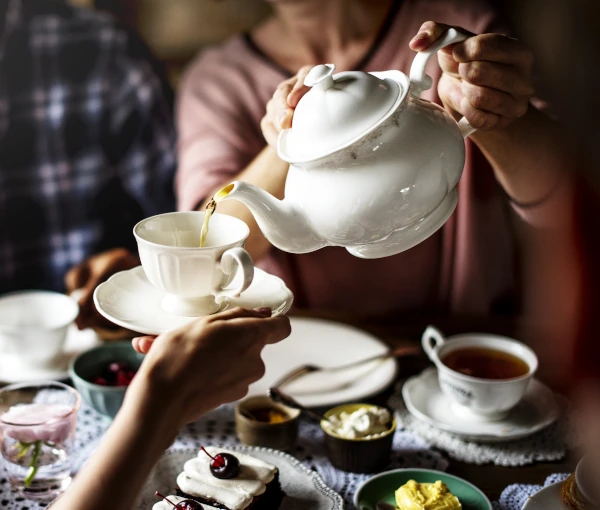Ever wondered how to host an afternoon tea that not only delights the palate but also caters to a vegetarian lifestyle? With the rise in plant-based eating, vegetarian afternoon tea has become a charming, inclusive option for gatherings. This guide will navigate you through crafting an enchanting tea experience, filled with scrumptious bites, exquisite teas, and stunning presentations. Discover essential tips and creative ideas to ensure your vegetarian afternoon tea is memorable and hassle-free, sparking joy for you and your guests alike.
Table of Content
- What is a vegetarian afternoon tea?
- How can I create a varied menu for my vegetarian afternoon tea?
- How can I accommodate dietary restrictions in my afternoon tea?
- What are some creative tea pairing suggestions for vegetarian dishes?
- Which herbal teas pair well with sweets?
- What black teas enhance savoury flavours?
- How do fruit infusions work with pastries?
- How can I enhance the presentation of my vegetarian afternoon tea?
- What are some colour combinations that work well?
- How can I use garnishes effectively?
- What types of serving ware are best?
- What are the common mistakes to avoid when hosting a vegetarian afternoon tea?
- How can I make my vegetarian afternoon tea memorable for guests?
- Conclusion
What is a vegetarian afternoon tea?
A vegetarian afternoon tea is a variation of the traditional British afternoon tea that excludes meat and fish, offering plant-based alternatives instead. This type of afternoon tea maintains the classic structure of an afternoon tea experience, typically consisting of three main courses: savory sandwiches, scones with clotted cream and jam, and a selection of sweet treats, all of which are prepared without meat or fish.
When you plan your vegetarian afternoon tea, focus on combining fresh ingredients and visually appealing arrangements. The savoury bites and sweet treats should offer a mix of textures and flavours, while your tea selection can elevate the experience.
What types of savoury bites are recommended?
When it comes to savoury bites, a vegetarian afternoon tea doesn’t fall short on variety and taste. Here are some excellent options for a vegetarian spread:
- Cucumber sandwiches with cream cheese and herbs
- Egg salad sandwiches on whole grain bread
- Hummus and roasted vegetable wraps
- Mini quiches with spinach and feta
- Cheese and tomato scones
Each of these savoury bites brings something unique to the table. The cucumber sandwiches are refreshing, the egg salad sandwiches are creamy, and the hummus wraps offer a delightful crunch. Mini quiches can be made in advance and served warm, while cheese and tomato scones add a savoury touch.
Next, focus on the presentation.
How can I present my tea table attractively?
Presentation is key to making your vegetarian afternoon tea not just tasty but also visually appealing. Here are some tips to make your tea table inviting:
- Use a tiered cake stand to display your treats.
- Arrange flowers in a small vase for a touch of elegance.
- Use matching china or colourful plates to add charm.
- Place napkins with decorative folding.
- Ensure a mix of colours and textures in your food presentation.
A tiered cake stand doesn’t just save space; it also adds height and interest to your table. Flowers can be a simple yet effective way to enhance the decor, and matching china brings a cohesive look. Napkins with decorative folding are a small detail that makes your table look polished.
Now, let’s talk tea.
What are the best teas to serve?
The choice of tea can significantly impact your afternoon tea experience. Here’s a list of popular tea selections:
- Earl Grey for its distinctive bergamot flavour.
- Darjeeling for a delicate and floral taste.
- Green tea for a lighter, refreshing option.
- Herbal teas like chamomile or peppermint for caffeine-free choices.
- Chai tea for a spiced, aromatic experience.
Earl Grey and Darjeeling are classic choices that appeal to many. Green tea offers a healthier option, while herbal teas cater to those who prefer something caffeine-free. Chai tea adds a bit of exotic flair with its spices.
In the Victorian era, afternoon tea became a fashionable social event. Anna, the Duchess of Bedford, is credited with starting this tradition in the early 1840s. She felt peckish during the long hours between lunch and dinner and began inviting friends over for tea and light snacks.
This practice quickly caught on among the upper echelons of society, transforming from a simple meal to a delightful social occasion. The idea was to offer a variety of small bites and treats that could be enjoyed while chatting with friends, much like how we enjoy afternoon tea today.
Creating a varied menu for a vegetarian afternoon tea can be quite enjoyable. The key is to balance different tastes, textures, and dietary preferences. A well-curated selection should include savoury and sweet options, accommodate any specific dietary needs, and offer a delightful experience for your guests.
The table below provides a list of suggested dishes, their preparation time, and any dietary considerations. This helps you plan and ensure you cater to everyone’s preferences while keeping the preparation time manageable.
Table: Vegetarian Afternoon Tea Menu
| Dish | Preparation Time | Dietary Considerations |
|---|---|---|
| Cucumber Sandwiches | 10 minutes | Vegan, Low-calorie |
| Mini Quiches | 30 minutes | Gluten-free option available |
| Scones with Jam and Cream | 25 minutes | Nut-free |
| Hummus and Veggie Wraps | 15 minutes | Vegan |
| Fruit Tartlets | 35 minutes | Dairy-free option available |
| Caprese Skewers | 20 minutes | Gluten-free, Low-carb |
| Chocolate Dipped Strawberries | 15 minutes | Vegan option available |
| Chia Pudding Cups | 20 minutes | Gluten-free, Vegan |
This table assists in understanding the variety of dishes, balancing quick and more involved preparations, and ensuring everyone’s dietary needs are met. Let’s delve into more details about some of the dishes to make your menu planning smoother.
What are some savoury options for a vegetarian afternoon tea?
Savoury dishes set a solid foundation for any afternoon tea. They often serve as the main attraction before the sweet treats come into play. Given their importance, it’s essential to have a variety that appeals to different tastes.
- Cucumber Sandwiches: These are classic and straightforward. Slices of cucumber with a hint of cream cheese on soft bread make them light and refreshing.
- Mini Quiches: These small bites can be filled with spinach, cheese, and cherry tomatoes. You can also make a gluten-free crust to cater to specific dietary needs.
- Hummus and Veggie Wraps: These wraps offer a great vegan option. Fill them with hummus, shredded carrots, bell peppers, and lettuce for a crunchy and satisfying bite.
- Caprese Skewers: These skewers are easy to prepare and visually appealing. Thread cherry tomatoes, basil, and mozzarella balls onto skewers, then drizzle with balsamic glaze.
Savoury dishes provide a good balance to the sweeter elements of the tea menu. They can be easily modified to meet various dietary restrictions and are generally quick to prepare. This makes them perfect for hosting.
What are some sweet options for a vegetarian afternoon tea?
No afternoon tea is complete without a selection of sweet treats. These delightful bites complement the savoury foods and add a bit of indulgence to the experience.
- Scones with Jam and Cream: Scones are a staple for afternoon tea. Serve them warm with a dollop of strawberry jam and clotted cream. For a nut-free option, ensure no nuts are added to the dough.
- Fruit Tartlets: These tartlets are not only delicious but also quite versatile. Fill them with a variety of fruits like berries and kiwi, and offer a dairy-free cream filling for those with dietary restrictions.
- Chocolate Dipped Strawberries: These are simple yet elegant. Use dark chocolate for a vegan option, and they’re ready in no time.
- Chia Pudding Cups: These can be prepped in advance. Mix chia seeds with almond milk and let them sit overnight. The next day, top with fresh fruits for a gluten-free and vegan delight.
Sweet treats add that special touch to the afternoon tea. They allow guests to indulge a little and enjoy a balanced array of flavours.
Did you know that Queen Victoria popularised the afternoon tea concept during the 19th century? It started as a small meal to curb hunger between lunch and dinner. Over time, it became a social event, complete with elegant settings and a variety of foods. Hosting such an event today still carries a touch of that royal tradition.
I remember organising my first vegetarian afternoon tea. I fretted over every detail, from the sandwich fillings to the type of tea. However, the moment my friends and family sat down and started enjoying the spread, all my worries melted away.
We laughed, chatted, and savoured each bite, creating memories that I still cherish. Whether you’re hosting a big gathering or an intimate tea, the joy it brings is truly special.

What are some easy vegetarian recipes for afternoon tea?
Right, so you’re having a few mates over for an afternoon tea and you don’t want Aunt Mildred eyeing your food suspiciously because it’s all green, right? Fear not, because cooking up some impressive vegetarian bites for your afternoon tea doesn’t have to be complicated or insipid.
Think mini quiches, colourful fruit tarts, delectable scones, delightful finger sandwiches, and, of course, some pastries that even Gordon Ramsay would approve of. Let’s make it straightforward, shall we?
Vegetarian mini quiches are the ultimate crowd-pleasers. They can be packed with a variety of veggies like spinach, bell peppers, and caramelised onions. Plus, they look fancy but require minimal effort. Fruit tarts are both delicious and Instagram-worthy, bursting with fresh berries, kiwi slices, and a dollop of cream or custard.
Now, scones are the quintessential part of any afternoon tea. Fresh, golden, and slightly crumbly scones just begging to be lavished with clotted cream and jam are a winner. Finger sandwiches, the tiny but mighty favourites, can be filled with anything from cucumber and cream cheese to roasted veggies and hummus.
And let’s not forget pastries – a bit of creativity here goes a long way.
What are the key ingredients for scones?
When it comes to scones, simplicity is the name of the game. The essential ingredients can usually be found in your pantry, which means you don’t need to embark on an epic quest to find them.
- Flour, typically self-raising, will give the scones volume.
- Butter ensures the scones are rich and crumbly.
- Sugar adds a touch of sweetness; you can adjust it to your preference.
- Milk to bind the ingredients into a dough.
- Eggs for structure and colour.
- Baking powder if you’re using plain flour for an extra rise.
Make sure your butter is cold, and you mix it in just enough until it resembles breadcrumbs. And, don’t overwork your dough – you want scones, not hockey pucks!
How can I make my pastries more appealing?
You want your pastries looking like they stepped straight out of a French patisserie and not your mum’s kitchen from the 80s. Presentation and creativity are key.
- Sprinkle icing sugar or cocoa powder on top for an elegant finish.
- Use a bit of glaze – think apricot jam melted with a touch of water.
- Fillings are where you can shine. Try a mix of fruit preserves, chocolate, or custard.
- Shape them into interesting forms like twists, pinwheels, or flowers.
- Garnish with fresh fruit, nuts, or edible flowers for that wow factor.
Honestly, half the battle with pastries is just making them look as good as they taste, so get a tiny bit fancy with them.
What are some tips for making finger sandwiches?
Finger sandwiches may be small, but they pack a punch, especially when they’re made right. The trick is in the details and a bit of a flourish.
- Use fresh, soft bread – stale bread is a no-go.
- Cut the crusts for that classic finger sandwich look.
- Spread a thin layer of butter or cream cheese to prevent the sandwiches from getting soggy.
- Get creative with fillings: cucumber and mint, roasted red pepper and feta, or egg salad with a twist, perhaps with a bit of curry powder.
- Slice them into even, bite-sized portions for easy munching.
Layer those ingredients evenly so every bite is the same. A dainty sandwich is a happy sandwich!
During the 19th century, afternoon tea became a social event in England. The Duchess of Bedford, Anna, is credited with creating the tradition around the 1840s. This clever woman found a way to fill the long stretch between lunch and dinner with a light meal and a bit of gossip.
She soon began inviting friends and serving tea accompanied by small bites, such as those we’ve mentioned. This habit caught on faster than a viral TikTok challenge, and eventually, it became a fashionable social occasion.
So, when serving your delectable vegetarian treats, remember you’re perpetuating a practice beloved by the aristocracy. How’s that for a historical twist?
How can I accommodate dietary restrictions in my afternoon tea?
Alright, let’s tackle the age-old challenge: How on earth do you accommodate Sheila’s gluten intolerance, Tom’s nut allergy, and Jake’s insistence on everything being vegan in your fancy afternoon tea party? It might sound like a culinary nightmare, but with a bit of planning and a sprinkle of creativity, you can make everyone happy. Let’s break it down.
First off, gluten-free options. Sheila shouldn’t have to miss out on those delightful scones you’ve perfected. Then, there are the nut-free recipes. Avoiding a medical drama at tea time is a good idea. Vegan alternatives? Absolutely! Plenty of yummy vegan goodies out there. Lastly, don’t forget about lactose-free choices and portion control. It’s all about balance.
What are some gluten-free alternatives for scones?
Gluten-free scones can be a bit of a science experiment, but they’re absolutely worth the effort. Substitute regular flour with a gluten-free blend and you’re halfway there.
- Gluten-free flour: Bob’s Red Mill or King Arthur Flour are good options.
- Xanthan gum: Adds elasticity to the dough, making it less like a brick and more like a scone.
- Buttermilk: Use lactose-free buttermilk to keep it friendly for the lactose intolerant crowd.
- Fresh fruit: Blueberries, raspberries, or even dried cherries can make gluten-free scones sing.
- Binding agents: Egg replacements like flaxseed meal mixed with water can do wonders.
Gluten-free scones can be as buttery and soft as their wheat-based cousins. Keep the dough as cold as possible, use a light hand when mixing, and don’t over bake them. Voilà!
How can I ensure my dishes are nut-free?
Keeping your afternoon tea nut-free is crucial if you want to avoid an EpiPen party. Here’s how to dodge those pesky nuts:
- Labels: Always read them, and then read them again. Hidden nuts love to lurk in processed foods.
- Separate utensils: Avoid cross-contamination by using designated nut-free utensils.
- Nut-free spreads: Swop almond butter for sunflower seed butter.
- Nut-free chocolate: Yes, it exists. Check out Enjoy Life’s chocolate.
- Double-check recipes: Some surprising recipes sneak in nutmeg, which is actually a seed.
Staying nut-free can be a logistical challenge, but is completely doable. Better safe than sorry!
What vegan options can I include?
Vegan options are not only kind to animals but can also be absolutely delicious — no one will even miss the meat or dairy.
- Sandwiches: Cucumber and mint, roasted vegetables with hummus, or avocado and tomato.
- Scones: Vegan butter (like Earth Balance), almond milk or oat milk instead of regular milk.
- Pastries: Use aquafaba (chickpea brine) instead of eggs in your baking.
- Finger foods: Stuffed mushrooms, vegan spring rolls, and bruschetta.
- Desserts: Chocolate avocado mousse, fruit tarts with vegan custard, or chia seed puddings.
Vegans, rejoice! Afternoon tea can be deliciously plant-based with little effort.
Accommodating various dietary restrictions is doable without sacrificing taste or tradition. And here’s a little history nugget: Afternoon tea started in the early 19th century with the Duchess of Bedford – Caroline Astor popularised it among the elite.
She insisted on accommodating all her guests’ various tastes, illustrating that inclusivity in tea-time traditions isn’t a newfangled idea. So next time you’re planning tea, channel your inner Duchess and make it a grand, inclusive afternoon. Cheers to that!
What are some creative tea pairing suggestions for vegetarian dishes?
Vegetarian afternoon tea is not just about swapping ham sandwiches for cucumber ones. It’s about pairing the right teas with your carefully chosen veggie delights. The goal? Perfect harmony between flavours. So, let’s dive into some creative tea pairing suggestions that’ll make your vegetarian afternoon tea the talk of the town.
First up, think about the flavour profiles you’re working with. Mild, creamy foods like a delicate ricotta and spinach filo pie deserve something subtle yet full-bodied, like a green tea. You wouldn’t want a bold Earl Grey overshadowing that.
Then, there are the more robust offerings such as mushroom and caramelised onion tarts. These call for equally strong contenders like black teas to marry up nicely with their earthy richness.
Herbal teas are your versatile sidekicks. Their range of flavours can match a variety of vegetarian nibbles, from sweet to savoury. Whether it’s a delicate chamomile blending with honey-drizzled scones or a spicy chai complementing a falafel wrap, there’s a whole bouquet of herbal wonders waiting to be explored.
And don’t forget about fruit infusions. They’re the perfect pals for pastries, offering a refreshing counterpoint to buttery textures and sugary glazes.
Which herbal teas pair well with sweets?
Sweets and herbal teas are like peas in a pod—or should we say, scones and jam?
- Chamomile tea: Known for its calming properties, this one’s a great match for buttery, honey-drizzled scones or shortbread.
- Peppermint tea: Particularly good with chocolatey treats, its refreshing coolness cuts through the richness like a pro.
- Lavender tea: A floral option that pairs beautifully with almond-based pastries and anything with subtle floral notes.
- Lemon verbena: Tangy and bright, this one complements citrusy desserts like lemon drizzle cake or lime tarts.
- Rooibos: With its naturally sweet, nutty flavour, rooibos tea is perfect for pairing with fruity confections and creamy sweets.
Evaluating these combinations might seem like a finicky tea-conomics class, but it’s worth the effort. The goal is to achieve a delightful balance where neither the sweet treats nor the tea outshine each other.
What black teas enhance savoury flavours?
Black teas are the heavy lifters of the tea world, able to stand up to more intense flavours without breaking a sweat.
- Earl Grey: The hint of bergamot in Earl Grey makes it ideal for dishes with a citrusy or zesty component, like lemon-herb tarts.
- Assam: This robust, malty tea pairs fabulously with hearty, umami-rich dishes like mushroom quiche or caramelised onion tart.
- Darjeeling: Often referred to as the “Champagne of Teas,” it has a light, muscatel flavour that goes well with sophisticated vegetarian sandwiches and canapés.
- Lapsang Souchong: Its smoky flavour is the perfect partner for BBQ-flavoured veggie sliders or smoky aubergine dips.
- Ceylon: A versatile black tea with a bright, citrusy profile, it’s great for pairing with Mediterranean-inspired dishes like roasted pepper and feta bites.
The choice of black tea can elevate your savoury vegetarian snacks, adding layers of complexity that keep your taste buds on their toes.
How do fruit infusions work with pastries?
Fruit infusions are a delectable way to add a burst of freshness to your afternoon tea spread, especially with pastries.
- Berry blends: Whether it’s raspberry, strawberry, or a mixed berry infusion, these teas provide a sweet-tart contrast that’s perfect with cream-filled pastries and fruit tarts.
- Apple and cinnamon: This combo offers a nostalgic flavour that pairs beautifully with spiced cakes and apple turnovers.
- Citrus infusions: Think lemon, orange, or grapefruit infusions. These teas bring a zesty zing that cuts through the richness of buttery croissants and Danish pastries.
- Peach tea: Sweet and aromatic, peach infusions go splendidly with vanilla-flavoured pastries and puff pastries.
- Pineapple and mango: Exotic and vibrant, these infusions are a tropical delight when paired with coconut macaroons or pineapple upside-down cake.
Pairing your pastries with the right fruit infusion can elevate the entire experience, making each bite and sip a refreshing delight.
Back in the day, the British upper class knew a thing or two about a proper afternoon tea. Let’s take a leaf out of Queen Victoria’s book—quite literally. The Victorian era saw the rise of “high tea,” but don’t be fooled by its lofty name.
It was actually a hearty meal enjoyed by the working class. However, our dear Queen’s fondness for elaborate low tea events, complete with delicate pastries and fine teas, set the standard we aspire to today.
So, channel a bit of royal flair into your vegetarian afternoon tea, and your guests will leave feeling splendidly regal.
How can I enhance the presentation of my vegetarian afternoon tea?
So, you’re looking to jazz up your vegetarian afternoon tea, huh? Well, you’ve come to the right place. Presentation is half the battle—or maybe more—and I’ve got some top-notch tips to make sure your tea time dazzles your guests.
From colour coordination to garnishing, serving ware, and even table settings, I’ve got the whole shebang covered.
Alright, let’s roll up our sleeves and get right to it. After all, we want your veggie treats to shine like the culinary masterpieces they are.
What are some colour combinations that work well?
Colour coordination is like dressing up your food in its Sunday best. You want it to look as appetising as it tastes. The right colour palette can make your spread look fresh and inviting.
- Greens and Purples: Think cucumber sandwiches and beetroot hummus – classy and vibrant.
- Yellows and Oranges: Carrot sticks with mango salsa or turmeric-spiced biscuits will catch the eye.
- Reds and Greens: Caprese skewers with cherry tomatoes and basil. It’s basically a vegetarian visual feast.
- Blues and Whites: Blueberry scones with a touch of clotted cream. Regal, but not too formal.
- Earthy Tones: Mushroom pâté and wholegrain bread. Rustic elegance at its finest.
Play with these combinations, and your table will look like the Cover of a high-end, foodie magazine. Trust me.
How can I use garnishes effectively?
Garnishes aren’t just the sprinkles on the cake; they can add flair to your fare. But, overdo it, and it looks like a tossed salad explosion (not a good thing).
- Herbs: Fresh parsley, coriander, or basil leaves can elevate the look of almost any dish.
- Edible Flowers: Nasturtiums, pansies, and violets add a splash of colour and make people think you’re fancy.
- Citrus Zest: A sprinkle of lime or lemon zest on savoury bites for that zing.
- Chopped Nuts: Crush some pistachios or almonds for texture and a pop of colour.
- Microgreens: These tiny greens like arugula or mustard cress make the plate look chef-inspired.
Garnishes should complement the flavours, not overwhelm them. Think of them as the accessories to your culinary outfit.
What types of serving ware are best?
Choosing the right serving ware is like picking the right backdrop for a stage performance. It matters!
- Tiered Stands: Classic and perfect for an array of nibbles. It screams ‘afternoon tea’.
- Charming Teapots: Opt for ceramic or porcelain ones that add a touch of class.
- Unique Plates and Bowls: Mix and match for a whimsical touch. Go vintage, and you’ve got a conversation piece.
- Cutlery and Tongs: Small tongs for self-service and dainty forks or spoons. It’s all in the details, buddy.
- Serving Trays: Wooden or mirrored trays can bring an element of rustic or modern sophistication.
Playing around with your serving ware can set the right mood and tone. Don’t be afraid to experiment.
Ever heard of the Mad Hatter’s Tea Party? No, I’m not advising you to go bonkers, but consider this: In 1865, Lewis Carroll’s “Alice’s Adventures in Wonderland” made eccentric tea parties iconic.
The blend of oddities and whimsy inspired generations. While you don’t need a talking hare or a grinning cat, sprinkling a bit of imaginative flair—like Carroll did—can turn an ordinary tea into an extraordinary affair that your guests will remember for years.
What are the common mistakes to avoid when hosting a vegetarian afternoon tea?
Alright, hosting a vegetarian afternoon tea seems like a piece of cake. But, plot twist—it’s not! Let’s dive into some common mistakes you want to steer clear of to avoid your dainty do turning into an absolute disaster.
No one wants a PhD to understand your menu. Keep it classy, but simple. For example:
- Remembering popular vegetarian options like cucumber sandwiches.
- Including easy-to-make treats such as scones and clotted cream.
- Using seasonal fruit tartlets because nobody says no to fresh berries.
Neglecting dietary needs
Susan’s gluten intolerance and Bob’s lactose-free diet mean you better have alternatives. Always:
- Providing gluten-free bread.
- Offering dairy-free cream cheese or vegan butter.
- Including nut-free and allergen-friendly options.
Poor timing
Serve cold tea, and your guests might just serve you some cold shoulders. Ensure:
- You keep the tea flowing hot.
- The scones arrive freshly baked, not oven-warmed.
Inadequate preparation
Last-minute rushing is a recipe for chaos. Ensure you:
- Lay the table the night before.
- Prep ingredients in advance, making assembly a breeze.
Lack of variety
Variety is the spice of life, and it keeps your afternoon tea lively. Maintain:
- A mix of savoury and sweet.
- Different bread options like whole grain, rye, or even gluten-free.
How can I ensure I have enough variety?
Nobody enjoys a monotonous spread where each bite feels like the last. Here’s how you amp up the variety:
- Think savouries and sweets: From mini quiches to éclairs.
- Offer different teas: Black, green, herbal, and fruity blends.
- Mix textures: Fluffy scones, crunchy veggies, and creamy cheeses.
- Choose a blend of seasonal and classic items: Strawberry summer tarts vs. Christmas mince pies.
- Heighten colours: Bright red berries, green spinach tarts, and golden pastries.
For instance, adding vibrant dishes like roasted pepper and goat cheese crostini brings a burst of colour and taste. Incorporate multiple types of finger sandwiches—think tomato and basil, avocado and hummus. Throw in some spiced chai for kicks.
What should I do to avoid timing issues?
Timing is everything. You don’t want scones hotter than a summer day or tea colder than your ex’s heart. Here’s a time-management blueprint for you:
- Prepare items that can be made ahead: Like chilling your cheesecakes overnight.
- Set a precise schedule: For example, tea at 3:00 PM on the dot, sandwiches 15 minutes prior.
- Use timers: Your best friend to ensure you don’t burn anything.
- Serve in waves: Instead of all at once, to keep it flowing.
Imagine pulling out freshly baked items at intervals rather than a cold buffet. Serving tea in waves keeps it fresh and makes guests feel pampered. Always have different cheese plates prepped and covered, ready to unveil when the moment’s right.
A simple menu does not mean boring. It’s about being chic, not being pretentious. Here’s a cheat sheet:
- Adopt classics: Think cucumber sandwiches, scones, and Victoria sponge cake.
- Cut complexities: Avoid advanced dishes that need too many steps.
- Use pre-made items: Like store-bought pastry dough.
- Focus on seasonal ingredients: They’re fresher and often need less fuss.
- Repeat crowd favourites: If it ain’t broke, don’t fix it—guests never get tired of well-made scones.
By paring down to tried-and-true favourites like mini quiches and fruit tarts, you save yourself a headache. Sticking to fresh-cut veggies and simple dips or spreads, like hummus, means less to manage and more to enjoy.
How can I make my vegetarian afternoon tea memorable for guests?
So, you’ve decided to throw a vegetarian afternoon tea and want to knock your guests’ socks off. Bravo! Creating a memorable afternoon tea is all about the details, darling. From unique themes and engaging activities to personal touches and tiny take-home favours, you’ve got plenty of angles to nail this.
Trust me, they’re more likely to Instagram the heck out of your soiree than forget it. Let’s dive in, shall we?
Unique themes for your tea party
Themes are where you can let your imagination run wild. Think of your vegetarian afternoon tea as a blank canvas. A unique theme can transform simple finger sandwiches into an Alice in Wonderland-style Mad Hatter’s snack fest.
Here are some cracking ideas to get your creative juices (or is that herbal teas?) flowing:
- Garden Party: Deck out the venue with vibrant floral arrangements and serve items like cucumber sandwiches, cherry tomatoes, and fresh herbs. Perfect for outdoor settings.
- Vintage British: Bring out the mismatched china, floral tablecloths, and serve up classics like scones with clotted cream and strawberry jam—minus the meat.
- Alice in Wonderland: Quirky and whimsical, using mismatched tea cups, quirky décor, and “Eat Me” and “Drink Me” labels for your veggie treats.
- Seasonal Produce: Center your menu around what’s fresh and available. Think pumpkin spice scones in autumn and strawberry tarts in summer.
- Herbal Wonderland: Incorporate various herbal teas into every dish. Think chamomile-infused cookies and minty little cakes.
Feeling inspired yet? It all starts with a theme that screams “you.”
Incorporating storytelling into the experience
Anyone can sling some veggie sandwiches and call it an afternoon tea, but you—oh, you—are going to take your guests on a gastronomical journey. Here’s how you turn your meal into a storybook:
- Menu Narratives: Instead of just listing items, describe them with a bit of flair. “Sun-kissed tomato, and basil bruschetta” sounds far more appealing than “bruschetta,” doesn’t it?
- Historical Tidbits: Intertwine the history of afternoon tea with the unique aspects of vegetarianism. Did you know Queen Charlotte popularised vegetarian dishes at tea?
- Personal Stories: If your grandma’s secret oatcake recipe is on the menu, let everyone know! It adds a warm, personal touch.
- Interactive Cooking Stations: Let guests concoct their own sandwiches or decorate their own cupcakes. Fun and tasty.
- Themed Background Music: Play tunes that fit your theme. Gentle harp for a traditional British tea, or whimsical piano for that Alice in Wonderland vibe.
Storytelling turns an ordinary array of dishes into a rich, engaging experience guests will remember (and rave about).
Types of favours to consider
Now, let’s talk gifts. Everyone loves taking a little something home as a memento. The trick here is to keep it themed and thoughtful:
- Mini Herb Pots: Not only do they look adorable, but they’re also practical. Your guests can grow their own basil or thyme.
- Homemade Jams & Spreads: Who can resist a tiny jar of homemade strawberry preserve or vegan lemon curd?
- Custom Tea Blends: Create your own tea blend and give them in small jars or decorative bags. Include recipes for how to prepare it.
- Cookie Cutters: Shapes that go with your theme, like teapots, flowers, or even rabbits for an Alice in Wonderland theme.
- Personalised Notebooks: Handy for jotting down their fav veggie recipes or tea party ideas from your fab event.
Simple, thoughtful favours can go a long way in making your vegetarian afternoon tea unforgettable.
Ah, where would we be without a good story? Picture this: Queen Victoria was so taken with the concept of “teatime” after a trip to Edinburgh that she integrated it into her royal routine. Word spread like wildfire, and soon it became a quintessential British tradition.
She even insisted on adding more plant-based items to balance the extravagant meat-heavy dishes. Her move to a more balanced lift included the introduction of delicate cucumber sandwiches, setting a standard for the elegant nibbles we cherish today.
So, when you’re serving your chic, veggie-filled afternoon tea, know you’re in royal company.
Conclusion
As I reflect on the journey of hosting a delightful vegetarian afternoon tea, I find that it’s not merely about serving food; it’s about creating an experience that brings together the flavours, colours, and conversations that accompany it.
The essential components we’ve explored—from savoury bites like mini quiches and finger sandwiches to delectable sweet treats such as fruit tarts and scones—form the foundation of a gathering that can cater to a variety of tastes and dietary needs.
Each element, from the selection of teas to the artistic presentation, plays a vital role in making the event more than just a meal; it transforms it into a memorable occasion.
The significance of these considerations is profound. A well-curated menu can accommodate diverse dietary restrictions, ensuring that everyone feels included and valued. Think of the joy on your guests’ faces as they enjoy gluten-free scones or savour vegan pastries, all paired with the perfect tea.
In a world where dietary needs often isolate us, your afternoon tea can become a sanctuary of inclusivity and creativity.
Moving forward, I encourage you to experiment with the ideas we’ve discussed. Consider the opportunities for further exploration, whether that means discovering new flavour pairings or creating unique themes that resonate with your personal style.
The table we constructed serves as a guide, but it is essential to adapt and innovate to reflect your individuality and your guests’ preferences.
As I wrap up this discussion, I invite you to ponder a thought: What stories can your next afternoon tea tell through its diverse menu and thoughtful presentation? Perhaps as you prepare for your gathering, you’ll reflect on how each dish can offer more than nourishment—it can share a narrative, evoke memories, and foster connections.
After all, hosting a vegetarian afternoon tea is a chance to celebrate both the joy of food and the bonds we create with one another. So, as you set your tea table, remember, it’s all about the delightful experience you offer, one cup of tea at a time.
Resources
- Herbal Teas and their Health Benefits: A Scoping Review
- Health Benefits of Tea
- Effects of alternative sweeteners with or without xanthan …
- The Impact of Vegan and Vegetarian Diets on Physical Performance and Molecular Signaling in Skeletal Muscle
- Food Perception and Aesthetics – Linking Sensory Science to Culinary …
- Tea (Camellia sinensis): A Review of Nutritional Composition …







